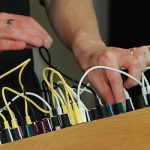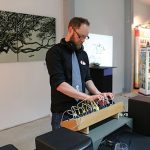Industry: Modular Synthesizers
Industry: Modular Synthesizers
Hidden away in basements and bedroom studios exists an ever growing musical addiction; one that leads to new musical possibilities, previously unheard sounds, and an empty wallet.
This is the world of modular synthesis, where a musician’s instrument looks more suited to scientific lab than to a music studio, and the music it creates can vary from conventional sounds to avant-garde noise and screaming atonal sirens. This means of making music is slowly emerging in New Zealand.
Right now, apart from the occasional performance at the Audio Foundation and the notable performance by Westley Holdsworth at Auckland’s Psych Fest, modular synths remain little regarded by local musicians.
However the tables are slowly turning. People who are interested in electronic music, and even audial experimentation, are coming to realise the freedom and possibilities that modular systems can provide.
For those unsure about what exactly a modular synthesizer, or even what a synthesizer is, here is a run down. There are several kinds of synthesis but we will look at the one that arguably started it all, and is currently still the most commonly used – subtractive synthesis.
We start our sound with a circuit called an oscillator that creates a tone at a stable pitch in a certain wave shape. Which wave shape is used determines how harmonically rich the tone is.
A perfect sine wave contains only one harmonic i.e. the root note, while a true square wave (imagine a signal that is switching between 100% on and 100% off per cycle) contains several audible harmonics that are both mathematically and musically interesting.
Waves rich in harmonics (the other common wave is a saw wave, a signal starting at 100% and moving down to 0% per cycle) are good starting points as they offer a lot of harmonic possibilities for a musician to work with. Harmonics are important as they make different timbres and create distinctions between instruments and sounds.
A human voice and a trumpet sound distinctly different, even when they are both holding the same note at the same volume. This is because of the harmonic content found in each sound.
Having a lot of harmonics gives the potential to create a lot of sounds, and this the reason why a pure sine wave is often left out of subtractive synths – they have no harmonics and are too sonically boring.
While a square wave may have a lot of harmonics, it could be described as sounding too harsh and piercing on its own. To resolve this, the oscillating tone is passed through a filter that can filter out certain harmonics. A filter starting from the highest harmonics and moving down is known as a low-pass filter (LPF), while doing so from the lowest harmonics and moving up is know as a high-pass filter (HPF).
Both create very different sounds, however the LPF is the most commonly used and the most distinct. When this filter is opened or closed it can have a little bump known as the peak, or resonance, that boosts the level of harmonics before quieting them, creating a the distinct ‘quacky’ sound that is associated with a synthesizer.
The easiest way to demonstrate this is with your own mouth. With your mouth closed, make a humming sound and slowly open your mouth as widely as you can and then close it again. You’ll notice that as you open your mouth you’ll hear the sound become brighter in tone and that you can hear certain harmonics resonating in your mouth. Filter resonance works in the same way.
So we have oscillators and filters. As well as these circuits a synth would also have amplifiers to amplify the sounds, envelopes that control the shape of the sound, LFOs (low frequency oscillators) that are used to create vibrato, tremolo, or filter sweeps (like the ‘wub-wub’ sound of dubstep bass), noise sources for creating sound effects, external-inputs, feedback generators that can overdrive the filters, sequencers… the list can go on.
Each circuit can create new sonic possibilities, depending on how they are used. This is where the distinction between a modular synth and a ‘normal’ synth can be found. A ‘normal’ synth, such as one of the first commercial synths, the Minimoog Model D (note: Moog is not pronounced like ‘mood’ but rather like ‘vogue’), has the layout of these different circuits predetermined.
Three oscillators with pitch control and wave shape options, along with a noise source and the option of an external input go through a filter that is controlled with an envelope.
This is then amplified to a line level that so that is can be heard when plugged into an amp or a mixer. One of the oscillators can also be used as an LFO by slowing it down to a very slow rate and set to modulate both the pitch of the oscillators and the filter sweep.
While the Minimoog sounds fantastic and offers a lot of sounds, compared to a modular synth the layout is limiting.
With a modular synth each of those circuits are individual modules that are not hardwired together in a predetermined order as is the case with the Minimoog but instead have the necessary inputs and outputs for sounds and modulation sources.
These are plugged into each other using cables by the musician, which allows the user to wire the instrument in any way they desire. The appeal of both ‘normal’ and modular synths quickly becomes apparent.
A ‘normal’ synth is accompanied with a keyboard, it is easy to program sounds, can usually save different sounds to be recalled later on, and is usually much easier to take to a gig or studio.
A modular synth on the other hand, while bigger and heavier, can have significantly more sonic possibilities and its size is only limited by a financial budget – and while a keyboard is not always necessary it isn’t hard to have one accompany a modular synth.
Scott Brown, who uses a modular system in his project Fake Empire, enjoys his modular synth because of the fact that there are no presets.
“It forces you to exist in the moment without over-thinking what you’re doing. Every patch you make will never sound quite the same as it does in that moment.”
Similarly, James Noble of Wellington modular duo Selective Yellow thinks that modulars synths “…feel more like an instrument than a computer.”
Historically, modular synths came first, with a wide range of companies emerging in the late 1960s – Moog, Buchla, EMS, E-MU and ARP to name a few. These synths offered big studios and top musicians such as The Beatles an expensive but exciting new way to make sounds.
As time went on these businesses began to fill the market with smaller and cheaper ‘normal’ synthesis options for (more average) musicians.
Modular synths soon became a rarity and not necessary to make interesting synthesized sounds. But as time passed from the late ’60s to the mid ’90s, electronics had become cheap enough that manufacturers like the German company Doepfer could begin selling new modules and modular systems at a reasonable price.
This, along with the controversial belief some people held that the digital synths of the ’80s and ’90s were not all they had set out to be, created a new demand for modular systems.
Since then the modular market has grown exponentially from a handful of manufacturers to several hundred, each offering their own version of classic circuits while also offering original modules that create new sounds, expanding modular synthesis beyond analogue subtractive synthesis to include a huge variety of other forms of synthesis, both analogue and digital.
While it can’t be argued that the technology offered by a computer is cheaper and easier to access, the modular industry still continues to grow. Its physicality and ability to mix and match any module from any company still provides something that working through a computer can’t.
So where do modular synths sit in the NZ musical community? As of now, not really anywhere. While those passionate about modular synths in other countries like Australia and the US have developed a hub and a community, NZ is too small and too far away in its own world, and modular synths remain too unfamiliar, too expensive and too cumbersome to get a hold of.
Beyond the local modular Facebook group, NZmodular, which currently sits at 100 members, there isn’t much more of a local modular community.
This is especially true when compared to a synthesizer hub like those found in Portland that sees successful module retailers and big synthesizer community events.
It is a dilemma for modular enthusiasts in NZ; retailers may be enthusiastic about modular synths, but are weary of importing modules because there is such a small market here and so many different manufacturers to choose from.
This in turn makes it difficult for people to get into modular synthesis. Those who do choose to delve into modular synthesis either tend to buy them second hand via TradeMe or through the modular Facebook page.
SAE tutor and regular NZM columnist David Chechelashvili is currently writing his PhD on modular synthesis. He started out with second hand gear bought both locally and overseas before determining exactly what modules he wanted.
But that can quickly become expensive. Modules range from $40 to well over a $1000, and a modular synth could contain anything from two or three modules to 30 or 40, or more.
A passionate modular synthesis enthusiast who has carefully selected the modules they want for their system has to pay not just the price of the module but also the difference in exchange rate and associated bank fees, expensive shipping for a one-off package to an unusual place (for the module manufacturer) like NZ, and then tariff charges and customs fees.
Fellow enthusiast, Tauranga-based Scott Brown agrees that because of the small local demand for modules it is not always simple, or cheap, to get the system you are after, but says the times are changing.
“We’re seeing somewhat of a modular revolution now that major companies like Roland and Moog have entered the market. It’s still difficult here in NZ as no one sells modules, so you still need to import everything from overseas.
Luckily there are some very reliable retailers in the US and Japan so it is possible to get hold of everything that is available globally.”
One of the attractions of a modular synth is that you can start out very small, but it can quickly become an expensive hobby.
Nevertheless there are Kiwi residents who are still passionate about modular systems, and those who have not taken the plunge into a manufactured modular system have found creative outlets through DIY projects varying from small noise boxes to full modular systems.
James Noble, professor at the School of Engineering and Computer Science at Victoria University in Wellington, thinks that electronic music will eventually ‘subsume all other forms of music,’ and this attitude is definitely reflected in the global market.
The huge rise in popularity of modular systems globally has seen not only hundreds of boutique companies emerge but also the larger synthesizer and keyboard players who are more conservative in their ventures delve into modular systems and analogue equipment.
Moog reissued their original modular synths (with price-tags varying from US$10,000 to US$150,000) along with new smaller semi-modular systems, Roland recently collaborated with a boutique company to re-issue their old line of modules, as well as issuing a new digital modular system.
Korg re-issued their semi-modular MS20 synth, and even some guitar pedal companies have expanded their product lines to include effects in a modular format. The concept of a modular synth is forever changing. Modular subtractive synths that were the ‘60s vision of the future, are now just one of many options for a modular set-up. There are dozens of different ways sound and even video can be synthesised and they can all be mixed up and criss-crossed with ease. Digital and analogue technology has become intertwined and musicians now have the ability to choose the best of both worlds for whatever sonic possibilities they desire to create.
It is only a matter of time before they become common place in a NZ electronic musician’s musical arsenal, as Scott Brown notes.
“Modular synths will change the way you make music and appreciate sound, but the learning curve is steep and requires a lot of patience and experimentation. With big companies entering the market it will be easier than ever to get your hands on an entry level setup.





